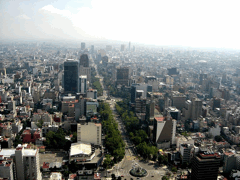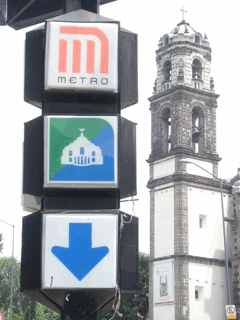Big City, Big Impact
Air Date: Week of November 20, 2009

Paseo de la Reforma as seen from Torre Mayor (Photo: Creative Commons.)
Big cities can make big strides in protecting the environment. Mexico City Mayor Marcelo Ebrard has ambitious plans for the city’s green future, as well as high hopes for the ability of big cities in general to initiate environmental change. Living on Earth’s Steve Curwood caught up with him during a recent visit to the states.
Transcript
YOUNG: Slow cities are, by definition, small cities. Some big cities are making environmental progress, too. By rethinking how people get around. Mexico City’s Metrobus project has cut CO2 emissions by an estimated 80,000 tons a year. Living on Earth reported on Metrobus when it started up in 2005.
[BUS SOUNDS]
JEFF: We spoke with former city environmental minister Claudia Scheinbaum.
SCHEINBAUM: We have substituted 350 buses for 80 buses, and the 350 buses used to be very old buses, so you have reduction in both in local pollutants and greenhouse gas emissions.
YOUNG: Mexico’s Metrobus was just honored by Harvard University’s Kennedy School of Government for its success. That’s where Living on Earth’s Steve Curwood caught up with Mexico City Mayor, Marcelo Ebrard. The mayor has ambitious plans to green the world’s largest cities.
CURWOOD: You’re off to Copenhagen. The 40 largest cities in the world, I believe, have come together, and a group of you mayors will be there. What do you expect to accomplish in Copenhagen as a mayor?
EBRARD: Well, we want to have an agreement between the most important cities of the world. And then to propose and to pressure the national governments and the global institutions to go faster than they go right now. And based in the effort that the cities already are doing. You take a look at Toronto, even New York, or San Francisco, or London. Every city in the world, the mayor part of them, are taking measures seriously, and fastly. And this is a global issue, so we cannot wait for the national governments to take the initiative because they are behind right now.
CURWOOD: So, what do you do to get national governments to move? What do you do to get your own government to move?

Metro Station in Alameda Central Park (Photo: Hajor, June 2004. Released under cc.by.sa and/or GFDL)
EBRARD: Well, we are pressuring every time to the government in our own country. I think that they understand that they should move faster. And we have an agreement because our plan in the city requires national decisions, for instance, what about the diesel? What about the car industry technology?
Should be a national-level decision, but the city have taken several measures in the past two years that move or pressure the federal government to move faster. For instance, we are going to have in Mexico City in 2011 the electrical cars from Japan and maybe, maybe United States. Maybe, I don’t know. So, this requires a new kind of decision from the federal level in order to supply the energy to the users of those cars, and to improve the regulations about the car industry technologies in Mexico. So, we are going to do this, at the same time the United States, UK, and the Canadian cities. So, it’s going to be a really important pressure to change the regulations in all those countries.
So, as far as I can see, the cities can lead these kind of decisions and really change things in the short term. Because, otherwise, we are going to wait – what, another five years? So, what’s going to happen?
CURWOOD: Now, if you look at the political spectrum, you’re considered more progressive, more to the left than your national government at home, which is considered to the right, more conservative. How do you overcome that gap, to get cooperation on these things?
EBRARD: So, we are talking to the young people, to the middle classes, also. In order to put these green issues at the top of the agenda and it’s working out.

Paseo de la Reforma as seen from Torre Mayor (Photo: Creative Commons.)
CURWOOD: Recently, I think you increased the number of days you can’t drive a car. You started to include Saturday, so that means that in any given Saturday, what a fifth of your voters are unhappy with you.
EBRARD: Well, you know, 80 percent of the people in the city uses right now public transportation facilities – 80 percent. So, it’s very different the situation in Mexico City than here. But, on the other hand I think that if you really want to do things – several times you take positions there are no popular measures, but can be effective. So, you cannot only run the city with service in the short term.
CURWOOD: Some might say that you’re positioning yourself to run for president in 2012. That if the national government doesn’t perform, you’ll hold up Mexico City as a green example on other issues to bolster your candidacy for president – what do you say?
EBRARD: Yes, why not? Why not, we need more equal society in Mexico. And new ideas about innovation. Let’s think in the 21st century, and not the 1st century. So, why not?
YOUNG: Steve Curwood talking with Mexico City mayor Marcelo Ebrard.
Links
Living on Earth wants to hear from you!
Living on Earth
62 Calef Highway, Suite 212
Lee, NH 03861
Telephone: 617-287-4121
E-mail: comments@loe.org
Newsletter [Click here]
Donate to Living on Earth!
Living on Earth is an independent media program and relies entirely on contributions from listeners and institutions supporting public service. Please donate now to preserve an independent environmental voice.
NewsletterLiving on Earth offers a weekly delivery of the show's rundown to your mailbox. Sign up for our newsletter today!
 Sailors For The Sea: Be the change you want to sea.
Sailors For The Sea: Be the change you want to sea.
 The Grantham Foundation for the Protection of the Environment: Committed to protecting and improving the health of the global environment.
The Grantham Foundation for the Protection of the Environment: Committed to protecting and improving the health of the global environment.
 Contribute to Living on Earth and receive, as our gift to you, an archival print of one of Mark Seth Lender's extraordinary wildlife photographs. Follow the link to see Mark's current collection of photographs.
Contribute to Living on Earth and receive, as our gift to you, an archival print of one of Mark Seth Lender's extraordinary wildlife photographs. Follow the link to see Mark's current collection of photographs.
 Buy a signed copy of Mark Seth Lender's book Smeagull the Seagull & support Living on Earth
Buy a signed copy of Mark Seth Lender's book Smeagull the Seagull & support Living on Earth

